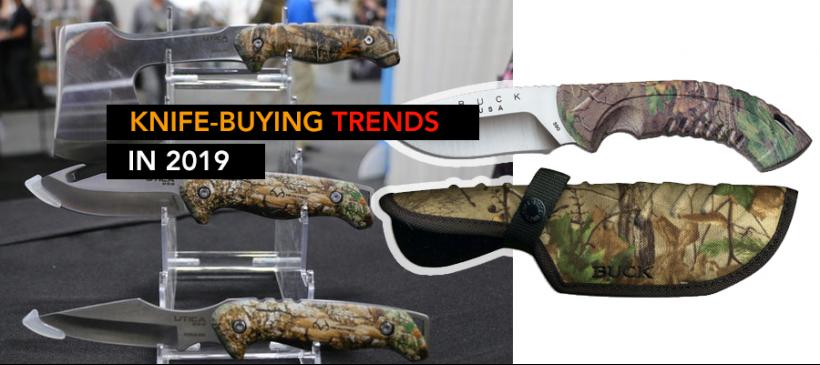Knife Buying Trends in 2019
- October 15, 2019
- By Team Realtree
- Research

Hunters, campers, anglers, shooters, hikers … What is the one universal tool that they would agree is indispensable? The answer should be obvious: a knife.
Not only does pretty much everyone who spends any time at all outdoors want and need a knife, most of them would agree there’s no downside to owning multiple knives. That’s great to news to anyone in outdoor retail or manufacturing, whether knives are their main business or an ancillary product line.
Knives are so varied in their design, price and function that it’s somewhat difficult to make generalizations about the knife market and knife buyers. To really understand the role that knives play for consumers who are part of the active outdoor lifestyle, it’s helpful to do some research, which is what the National Shooting Sports Foundation did recently. Working with the research company, Infomaniacs, the NSSF has published a new report, the Consumer Knife Market.
Here and in a series of upcoming blog posts, we’ll summarize some of the results with the goal of providing more insight into this staple outdoor industry product, which for the purposes of this study was divided into seven categories:
1. Hunting
2. Tactical
3. Survival
4. Rescue
5. Fishing
6. Outdoor recreation
7. Everyday Carry (EDC)
There is obviously crossover within those categories, and we’ll explain more about that. But first, we should answer the question of why an organization whose main purpose is to support the shooting sports would conduct a study on knives. From the report:
“Although you don’t need a knife to own and use firearms and vice versa, there appears to be a strong, if not symbiotic, relationship between the two. For example, it was shown in the ‘Concealed Carry Market – NSSF Report 2018’ that 75.5% of those who carry a firearm also carry a knife for self-defense. In this study, you will see that 93.3% of respondents own at least one firearm and 30% have purchased at least one knife at a firearms store … Clearly, the relationship between knives and firearms is both broad and deep … Thus, it makes complete sense for the NSSF to profile knife-owning consumers in the same way that it profiles firearms owners for the benefit of both the knife and firearms industries as well as the consumers these industries serve.”
To ensure the study represented the appropriate consumers, participants had to be hunting or sporting knife owners who were 18 years old or older, owned a minimum of three hunting and/or sporting knives, purchased at least one hunting or sporting knife in the past three years, and intended to purchase at least one more in the next 12 months. A total of 1364 respondents participated.
We’ll go into more depth in future blog posts regarding consumer buying habits, but here are a few of the top-level conclusions from the study:
1. The highest growth in knife and accessory purchases is likely to come from the youngest segment of consumers (18-34). They say they intend to purchase significantly more knives and accessories than those in the older categories, mainly in the EDC, tactical, survival and fishing knives categories than nearly all other age groups. They also spend more on accessories such as maintenance tools, replacement parts, cleaner/rust remover and replacement handles/scales. Interestingly, the anticipated spend on knives and accessories is not significantly different across all age groups. But the report also points out that these purchases are often made on impulse, and therefore the spend by younger knife owners may be more than they anticipate.
2. Regardless of knife type, five features have the most impact on purchasing decisions. These are the features that cross all seven knife types:
a. Ability to maintain a sharp edge
b. Can withstand hard use
c. Appropriateness for the task
d. Comfort in the hand
e. Blade material (steel, alloy, ceramic, etc.)
It’s very important to note which features matter the most in buying decisions when it comes to different types of knives, as the report points out:
“Beyond the top five features, feature importance begins to differentiate more by knife types. Hunting, tactical and fishing knives tend to group together, and survival and outdoor recreation knives group together. Survival and outdoor recreation are very closely correlated while rescue is more loosely associated with the two. EDC knives, the least specialized of the seven, tended to reflect average feature importance across all knife types.”
Also interesting, the report notes, is that 71.7% of respondents said that Made in the USA is important, compared with Lifetime Replacement Guarantee (64.6%), Value (58.6%) and Warranty (54.9%). Meanwhile, Brand, at 39.7% is not a primary driver when compared with the importance of physical knife features or aesthetic qualities.
3. EDC knives are, by far, the most commonly owned, owned in the greatest quantities and the type of knife most likely to be purchased in the next 12 months.
Another important summary finding is that nearly all (94.4%) of respondents said they own at last one EDC knife among their average of 22.3 knives owned. The average number of EDC knives reported was 5.76. And, most importantly, 72.7% of respondents said they intended to purchase another EDC knife within the next 12 months.
Hunting knives are the next most popular, with 85.1% saying they own at least one and 30.7% saying they planned to buy another in the next 12 months.
4. Outdoor specialty stores are the single retail channel that sees the most knife purchases, but online retailers, both online-only and other types of online stores, are nearly as important and will likely become more so with the growth of online retailing and the consolidation of outdoors specialty stores.
This trend is not surprising. In this study, “Over half (59.5%) of respondents purchased knives through outdoor specialty stores, making it the single most popular type of retail store for knife purchases. Although 43.6% of respondents purchased one or more knives from online-only retailers and 42.9% purchased at least one from other types of online retailers (e.g. mass merchants, Amazon) half (51.1%) bought at least one knife from both types of online retailers. Additionally, 63.1% … bought at least one knife through Amazon, making it the single most popular retailer for knife purchases.”
Editor’s Note: Come back to the Realtree Business Blog frequently for more industry insights on new products and outdoor industry trends. In future posts in this series on knives, we’ll look in more detail at different knife categories and buying habits within them.
